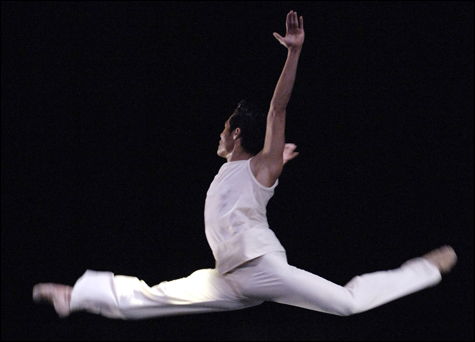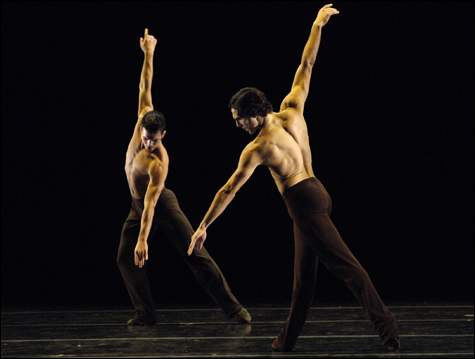
EIN VON VIEL: Taking us beyond gorgeous bodies doing dancedancedance. |
Boston Ballet artistic director Mikko Nissinen introduced the company’s “Next Generation” program Thursday night with a brief curtain speech celebrating the four choreographers whose works were being showcased. Incidentally Nissinen was staging himself, as an impresario of new talent. Jorma Elo, Helen Pickett, Sabrina Matthews, and Heather Myers were all spotted by Nissinen and recruited to spike the Boston repertory with contemporary ballets.
It was also Nissinen’s genial idea to put up Téssera, a little prologue piece for the choreographers, who weren’t dancing elsewhere on the program that evening. Directed by Elo to a tape-looped rhythmic fragment lifted from Sibelius, the four performed tiny solos establishing themselves as distinct dancing personalities, teaming in a couple of unison passages but maintaining their individuality.
The dances that followed all looked different but operated the same way in concept. Each one offered a banquet of ballet-powered movement superbly performed. Without characters or “argument” in the dramaturgical sense, they delivered dramatic encounters, erotic duets, and attention-grabbing stage effects. Each one used compelling music as a scaffolding on which to establish a mood or an energy. Only Sabrina Matthews’s ein von viel (“one out of many”), for a pair of men and an on-stage pianist, proposed that a work, even a modest one, could take us beyond gorgeous bodies doing dancedancedance.
With pianist Freda Locker on stage, playing selections from Bach’s Goldberg Variations, two men in white pants and tops began the dance side by side. You wouldn’t take them for well-matched partners — James Whiteside, tall and lanky, John Lam, dark and compact — but Matthews blended and contrasted them in a series of intricate movement inventions.
Their first canonic moves suggested the echo-and-consonance encounter of the two-man variation from George Balanchine’s Agon. But Matthews ventured deeper into compositional territory, as the dancers played off each other, copying moves but reversing them from left to right, displacing shapes or gestures to different parts of the body, plunging toward the floor instead of going into the air on a particular step. Each got a small solo, but the heart of the piece was their interlocking differences.

GONE AGAIN: Schubert’s lullaby/funeral march prompted no death forebodings or sexual anxiety. |
ein von viel (2001) was commissioned by Mikko Nissinen when he headed the Alberta Ballet and Matthews was dancing there. He’s given a similar opportunity to Alberta Ballet alumna Heather Myers, now a Boston Ballet second soloist. In Gone Again, with an ensemble from the Boston Ballet orchestra, three couples danced to the second movement of Franz Schubert’s String Quartet No. 14 in D minor (Death and the Maiden).Myers used a classical vocabulary pushed out of line here and there for expressionistic effects — tilting heads, thrusting upper torsos, off-balance leanings. Benjamin Phillips’s rustic rafters above the stage suggested some Bavarian folk tale in the background. The music’s reference is an ambiguous confrontation between a frightened young girl and a stranger who promises that if she comes away with him, she’ll sleep safely in his arms.
The dancers (Romi Beppu and Yury Yanowsky, Rie Ichikawa and Lorin Mathis, Kathleen Breen Combes and Raul Salamanca) could have been any ordinary courting couples. Schubert’s lullaby/funeral march prompted no death forebodings or sexual anxiety. Thoughtful, but not moved, they strolled out to Schubert’s tranquil closing chords.
Helen Pickett kneaded the classical line into sinuous curves and sexy seductions in Eventide, a formal dance for five women, five men, and a female ensemble of 10. Three musical selections by contemporary composers (Michael Nyman, Jan Garbarek, and Philip Glass) drew on Indian and Indonesian sounds as well as the driving pulse of post-minimalism.
Eventide began in some hermetic, exotic locale, perhaps a harem, with an electric guitar rummaging through ideas you might hear on an Indian sitar, extravagant red swags hanging at the sides, and a line of women along the edge of the stage. Wearing little besides panels of silvery fabric, the women face away from the audience to where Kathleen Breen Combes seems to be getting ready to entertain a male suitor. I wasn’t sure who she danced with, but as soon as the first man left, the other four appeared ceremoniously. The ballet continued as an extended exposition of its resources and hierarchies.
The principal men and women dance alone and in combinations that get remixed before you grow too attached to them. The corps women reassemble prettily around them. The setting changes twice — the red drapes disappear and the background goes black, then a large busy abstract painting drops down.
By the time Glass’s music starts to play (Meetings along the Edge, a rewrite of the last part of Glass’s score for Twyla Tharp’s In the Upper Room, with a pseudo-Bach line running over the top of it), the dancer forces begin collecting into a quite conventional ballet wind-up. I never did decide where or when all this was supposed to be taking place. Fortunately, I guess, the audience wasn’t let in on Pickett’s baffling list of sources, which included Edward Hopper and e.e. cummings.